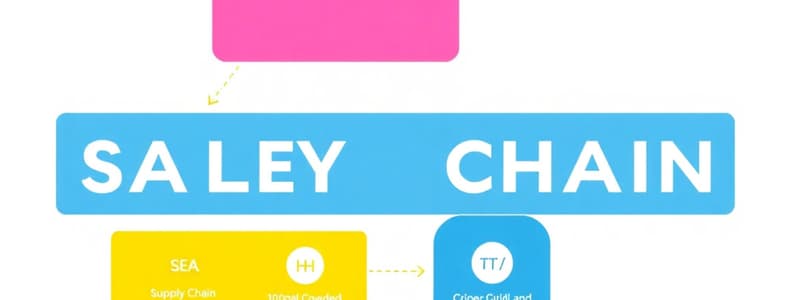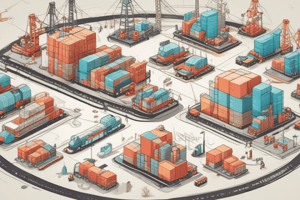Podcast
Questions and Answers
What is an imitation-resistant value chain?
What is an imitation-resistant value chain?
- A strategy that focuses on reducing costs without adding value
- A value chain that emphasizes only primary activities
- A value chain that is easy for competitors to replicate
- A unique business model that leverages technology and is hard to copy (correct)
What does the term 'straddling' refer to in a business context?
What does the term 'straddling' refer to in a business context?
- A strategy of occupying more than one business model ineffectively (correct)
- A situation where a company has no competitors
- The practice of only focusing on primary activities in a value chain
- The ability to compete in multiple markets effectively
Which of the following statements best defines the 'value' in a business context?
Which of the following statements best defines the 'value' in a business context?
- The total cost incurred by a business to create a product
- The willingness of a customer to pay for a product or service (correct)
- The total revenue generated by a business in a given period
- The profit margin a company aims to achieve
What are the two main categories of activities in the Value Chain Model?
What are the two main categories of activities in the Value Chain Model?
How is profit margin calculated in a company?
How is profit margin calculated in a company?
In the context of Starbucks' value chain, what does 'inbound logistics' refer to?
In the context of Starbucks' value chain, what does 'inbound logistics' refer to?
What challenge do late-moving rivals face compared to established firms?
What challenge do late-moving rivals face compared to established firms?
What is a key role of technology in an effective strategic position?
What is a key role of technology in an effective strategic position?
What is the primary purpose of safety stock in supply chain management?
What is the primary purpose of safety stock in supply chain management?
What effect does inaccurate information have within the supply chain?
What effect does inaccurate information have within the supply chain?
Which system is essential for managing the flow of information in supply chain management?
Which system is essential for managing the flow of information in supply chain management?
What is one significant issue associated with global supply chains?
What is one significant issue associated with global supply chains?
How can timely and accurate information sharing help prevent the bullwhip effect?
How can timely and accurate information sharing help prevent the bullwhip effect?
What is the 'push-based model' in supply chain management?
What is the 'push-based model' in supply chain management?
Which of the following best describes a demand-driven supply chain?
Which of the following best describes a demand-driven supply chain?
What is a significant advantage of using web-based applications in global supply chains?
What is a significant advantage of using web-based applications in global supply chains?
What is described as financial performance that consistently outperforms industry averages?
What is described as financial performance that consistently outperforms industry averages?
Which of the following best describes operational effectiveness?
Which of the following best describes operational effectiveness?
What concept suggests that defined characteristics of a resource can yield sustainable competitive advantage?
What concept suggests that defined characteristics of a resource can yield sustainable competitive advantage?
What is one major risk associated with companies relying heavily on technology?
What is one major risk associated with companies relying heavily on technology?
According to Michael Porter, what can result from firms focusing solely on operational effectiveness?
According to Michael Porter, what can result from firms focusing solely on operational effectiveness?
Which of the following characteristics is NOT associated with sustainable competitive advantage?
Which of the following characteristics is NOT associated with sustainable competitive advantage?
What is the primary concern when offerings among firms become too similar?
What is the primary concern when offerings among firms become too similar?
What challenge do firms face with technology-based competition?
What challenge do firms face with technology-based competition?
What are network effects primarily characterized by?
What are network effects primarily characterized by?
Which of the following best describes a two-sided market?
Which of the following best describes a two-sided market?
Which characterizes strategic positioning?
Which characterizes strategic positioning?
What role do switching costs play in network effects?
What role do switching costs play in network effects?
What is a key aspect of the FreshDirect model?
What is a key aspect of the FreshDirect model?
What is a function of APIs in modern technology?
What is a function of APIs in modern technology?
Which of the following is NOT a characteristic of exploitable resources for competitive advantage?
Which of the following is NOT a characteristic of exploitable resources for competitive advantage?
How do distribution channels affect a firm's success?
How do distribution channels affect a firm's success?
What is the primary goal of a firm seeking sustainable competitive advantage?
What is the primary goal of a firm seeking sustainable competitive advantage?
Which characteristic distinguishes commodities from other products?
Which characteristic distinguishes commodities from other products?
How can technology enhance a firm's resource-based competitive advantage?
How can technology enhance a firm's resource-based competitive advantage?
What advantage does OpenTable have in the restaurant reservation market?
What advantage does OpenTable have in the restaurant reservation market?
In the context of market strategies, what does being imitation-resistant mean?
In the context of market strategies, what does being imitation-resistant mean?
What is the sales per square foot of Murphy USA as listed?
What is the sales per square foot of Murphy USA as listed?
Which of the following best describes the resource-based view of competitive advantage?
Which of the following best describes the resource-based view of competitive advantage?
What is a crucial component of the value chain concept in relation to technology?
What is a crucial component of the value chain concept in relation to technology?
What does the value chain model primarily identify?
What does the value chain model primarily identify?
How does Information Systems (IS) contribute to a firm's value chain?
How does Information Systems (IS) contribute to a firm's value chain?
Which of the following is NOT a software tool mentioned in the value chain?
Which of the following is NOT a software tool mentioned in the value chain?
What is a primary function of the supply chain management?
What is a primary function of the supply chain management?
Which group is not a part of the distinct supply chain groups?
Which group is not a part of the distinct supply chain groups?
What could happen if inefficiencies exist in the supply chain?
What could happen if inefficiencies exist in the supply chain?
What is one advantage of a just-in-time strategy in supply chain management?
What is one advantage of a just-in-time strategy in supply chain management?
Which of the following statements regarding adopting systems like ERP is correct?
Which of the following statements regarding adopting systems like ERP is correct?
Flashcards
Operational Effectiveness
Operational Effectiveness
Performing the same tasks better than rivals. It focuses on efficiency and cost reduction.
Sustainable Competitive Advantage
Sustainable Competitive Advantage
A competitive advantage that is sustainable over time, consistently outperforming industry averages in financial performance.
Fast Follower Problem
Fast Follower Problem
A situation where a competitor observes a pioneer's efforts, learns from their successes and failures, and quickly enters the market with a similar or better product at a lower cost before the pioneer can dominate.
Strategic Positioning
Strategic Positioning
Signup and view all the flashcards
Value Chain
Value Chain
Signup and view all the flashcards
Porter's Five Forces
Porter's Five Forces
Signup and view all the flashcards
Resource-Based View of Competitive Advantage
Resource-Based View of Competitive Advantage
Signup and view all the flashcards
The Danger of Relying on Technology
The Danger of Relying on Technology
Signup and view all the flashcards
Technology and Strategic Positioning
Technology and Strategic Positioning
Signup and view all the flashcards
The FreshDirect Model
The FreshDirect Model
Signup and view all the flashcards
Powerful Resources
Powerful Resources
Signup and view all the flashcards
Resource Analysis
Resource Analysis
Signup and view all the flashcards
Strategic Thinking
Strategic Thinking
Signup and view all the flashcards
Benchmarking
Benchmarking
Signup and view all the flashcards
Role of IS in Value Chain
Role of IS in Value Chain
Signup and view all the flashcards
Software Tools in Value Chain
Software Tools in Value Chain
Signup and view all the flashcards
The Supply Chain
The Supply Chain
Signup and view all the flashcards
Upstream Supply Chain
Upstream Supply Chain
Signup and view all the flashcards
Downstream Supply Chain
Downstream Supply Chain
Signup and view all the flashcards
Internal Supply Chain
Internal Supply Chain
Signup and view all the flashcards
Imitation-resistant Value Chains
Imitation-resistant Value Chains
Signup and view all the flashcards
Straddling
Straddling
Signup and view all the flashcards
Value
Value
Signup and view all the flashcards
Profit Margin
Profit Margin
Signup and view all the flashcards
Primary Activities in a Value Chain
Primary Activities in a Value Chain
Signup and view all the flashcards
Support Activities in a Value Chain
Support Activities in a Value Chain
Signup and view all the flashcards
Safety Stock
Safety Stock
Signup and view all the flashcards
Bullwhip Effect
Bullwhip Effect
Signup and view all the flashcards
Supply Chain Management (SCM) Software
Supply Chain Management (SCM) Software
Signup and view all the flashcards
Demand-Driven Supply Chain
Demand-Driven Supply Chain
Signup and view all the flashcards
Push-Based Supply Chain (Build-to-Stock)
Push-Based Supply Chain (Build-to-Stock)
Signup and view all the flashcards
Pull-Based Supply Chain
Pull-Based Supply Chain
Signup and view all the flashcards
Global Supply Chains and the Internet
Global Supply Chains and the Internet
Signup and view all the flashcards
Challenges of Global Supply Chains
Challenges of Global Supply Chains
Signup and view all the flashcards
Commodities
Commodities
Signup and view all the flashcards
Network Effects
Network Effects
Signup and view all the flashcards
Distribution Channels
Distribution Channels
Signup and view all the flashcards
Affiliates
Affiliates
Signup and view all the flashcards
APIs (Application Programming Interfaces)
APIs (Application Programming Interfaces)
Signup and view all the flashcards
Two-Sided Market
Two-Sided Market
Signup and view all the flashcards
Switching Costs
Switching Costs
Signup and view all the flashcards
Control and Leverage a Leading Standard
Control and Leverage a Leading Standard
Signup and view all the flashcards
Study Notes
Chapter 2: Strategy & Technology
- Learning Objectives: Define operational effectiveness and understand limitations of technology-based competition. Define strategic positioning and its importance for competitive advantage. Understand the resource-based view of competitive advantage. List the four characteristics of sustainable competitive advantage.
The Danger of Relying on Technology
- Firms seek sustainable competitive advantage, which is consistently exceeding industry averages in financial performance.
- This is hard to achieve due to rapid new product and competitor emergence.
- Competitors often cut costs, prices, and increase features to gain comparative advantage.
- Porter's concepts (value chain, five forces) are useful for achieving comparative advantage.
- Firms using operational effectiveness (performing the same tasks better than rivals) can suffer aggressive, margin-eroding competition.
- Similarity and failure to innovate lead to a commodity status.
Fast Follower Problem
- Fast follower problem occurs when competitors: watch the pioneer's efforts, learn from successes and missteps, enter the market quickly with a comparable product at lower costs before the pioneer dominates.
- Technology can be quickly matched, making pioneers vulnerable.
- Example provided: Snapchat vs. Facebook (fast followers mimicking features)
Technology and Strategic Positioning
- Strategic positioning involves performing different activities than rivals or performing the same activities in a different way.
- Technology fosters novel and defensibly different business approaches, hindering imitation.
The Fresh Direct Model
- Provides innovations like efficient worker shifts, firm-owned goods preparation, high inventory turnover, AI/climate-controlled rooms.
- These innovations secure favorable supplier terms with stores.
- Data sharing between FreshDirect and suppliers optimizes sales and operations.
- Payments are made in days instead of weeks.
Resource-Based View of Competitive Advantage
- Firms must control exploitable resources with valuable, rare, imperfectly imitable, and non-substitutable characteristics for sustained competitive advantage.
Source of Competitiveness
- Sustainable competitive advantage stems from access to unique resources or efficient use of commonly available resources.
What is the Source of Competitive Advantage?
- A flowchart shows the steps to determine if a firm has sustained competitive advantage based on its valuable, rare, costly to imitate, and organized processes.
Chapter 2.2 Learning Objectives
- Understand that technology is vital for competitive advantage.
- Understand the value chain concept.
- Recognize technology's role in creating an imitation-resistant value chain.
- Understand and give examples of how technology shapes and enhances resources.
Powerful Resources
- Awareness of competitive advantage sources aids managers in identifying opportunities and vulnerabilities. This helps brainstorm winning strategies.
- Effective strategic positions create assets that support each other. These assets are difficult for rivals to replicate.
Imitation-Resistant Value Chains
- A superior business approach that competitors struggle to copy, with technology as a crucial element.
- The FreshDirect model is presented as an example.
- The concept of straddling (trying to occupy multiple positions but failing to excel in any one) is contrasted with a singularly focused competitor.
How Does Your Organization Create Value?
- Value is the amount a customer will pay and the essence of every business.
- Value creation and capture for a company is profit margin.
- Calculating margin involves subtracting the cost of value creation from the value created.
Value Chain Model
- A model of interconnected activities in a business, categorized as primary and support tasks.
- Primary tasks are those directly related to value creation: inbound logistics, operations, outbound logistics, sales and marketing, service.
- Support tasks are the underlying activities: firm infrastructure, human resource management, technology development, procurement.
- Businesses use the value chain model to identify areas for value creation or cost reduction
Value Chain Model, Example: Starbucks
- Inbound logistics: Choosing high-quality beans, managing transportation, and storage.
- Operations: Starbucks presence worldwide to produce a strong consumer base, and maintaining quality.
- Outbound logistics: Limiting retail sales outside of licensed shops.
- Sales/marketing: Relying on quality and reputation instead of aggressive marketing tactics.
- Service: Focus on building customer loyalty.
Value Chain Model: Support Activities
- Firm infrastructure: Strong resources in well-designed stores, efficient finance, and legal departments.
- Human resource management: Emphasizes benefits and training programs to maintain low turnover rates.
- Technology Development: Investment in technologies that maintain product quality.
- Procurement: Acquiring the best beans from dependable bean suppliers.
Importance of Value Chain Model
- The value chain model helps achieve operational excellence.
- It identifies critical activities within a business.
- Benchmarking against best practices can help establish operational excellence.
Role of IS in Value Chain
- Information systems (IS) address business process limitations in the value chain.
- IS improve process speed and quality.
- IS reduce operation costs.
- IS aid customer and supplied connections.
IS in Value Chain: Software tools
- Supply Chain Management (SCM) software links inbound and outbound logistics.
- Customer Relationship Management (CRM) automates sales and marketing.
- Enterprise Resource Planning (ERP) software can automate business activities.
Q&A (Questions)
- Is adopting a system that rivals can also buy automatically lead to competitive advantage? (Example provided: Dell's ERP system)
- Q: Is this a good change?
Supply Chain Management
- A supply chain encompasses flows of materials, information, and services.
- Organizations and their processes focus on procuring, transforming, and distributing products.
- The supply chain comprises: upstream supply chain (supplier relationships), downstream supply chain (delivering products to customers), and internal processes (materials and services into products.)
- A diagram depicts this structure. Using Nike as an example, the upstream includes supplier tiers, and the downstream refers to the distributor and retailer, leading to the customer.
The Supply Chain: Issues
- The increasing role of information systems (IS) in supply chains.
- Efficiencies in supply chain increase company operating costs
- E.g., part shortages, underused plant capacity, excess finished-goods inventory can waste up to 25% of operating expenses.
- Businesses use the just-in-time strategy to minimize expenses, and avoid warehousing costs and potentially excessive inventory.
Supply Chain Management: Concepts
- Safety stock is a buffer against uncertainty, like demand fluctuations, or defective materials.
- The bullwhip effect describes how distorted information concerning product demand can propagate through the supply chain.
- Timely and accurate information mitigates this.
- Diagram of the bullwhip effect illustrates how minor variations in consumer demand ripple through the supply chain.
Supply Chain Management (SCM) Software
- Supply chain planning systems facilitate information flow. They generate demand forecasts. They aid coordination. They match production to demand.
- They coordinate activities with other supply chain partners.
Global Supply Chain
- Many components make up a global supply chain (e.g., a Boeing 787).
- Parts come from multiple countries across various continents.
- Utilizing web-based apps for information exchange is common in global supply chains for global visibility.
- This helps managers determine if inventory and production resources match current demand.
Global Supply Chains and the Internet: Issues
- Increased geographical distances create supply chain complexities.
- Different time zones can cause problems.
- International participants (and their specific business practices) make working across borders intricate.
- Varied legal requirements further complicate the process.
- Businesses use outsourcing and third-party logistics to manage these complexities (e.g., manufacturing, logistics, apparel industry using Li & Fang and China).
Demand-Driven Supply Chains
- Push-based (build-to-stock) model: Creating products based on predicted demand.
- Pull-based (demand driven) model: Products manufactured in response to customer orders, which Dell uses exemplifies this model.
Push-Versus Pull-Based Supply Chain Model
- A diagram illustrates how the push-based model anticipates demand, and the pull-based model responds to actual orders.
- Push vs. pull summary, "Make what we sell, not sell what we make."
Pros and Cons of Pull-based SC
- Pull-based models excel at providing high customer service levels.
- Reduced inventory is a great benefit.
- However, fulfilling customer orders can take longer. Costs can be higher.
- Most businesses utilize a hybrid approach, combining push and pull elements.
Brand
- A brand is the symbolic representation of a product or service information.
- A strong brand is crucial for gaining a competitive edge.
- Customers use brands to evaluate product quality.
- Technology reinforces and strengthens brand identity in an efficient and cost-effective manner—e.g., viral marketing.
Scale Advantages
- Businesses gain cost benefits—economies of scale—by spreading costs across higher production or customer service volumes.
- Scalability means a business can grow effectively.
- Greater scale typically relates to stronger purchasing power with suppliers/buyers.
Switching Costs
- Costs customers experience when moving from one product/service to another.
- Switching costs can be monetary or non-monetary.
- (Examples include learning costs, financial commitments, contractual obligations, search costs, and brand loyalty programs.)
Value of Service and Switching Costs
- For a successful competitor, value creation and capture must not only be higher than the established company, but also surpass the customer's switching costs.
Differentiation
- Technology plays a crucial role in making goods and services unique.
- Commodities are goods or services offered identically by multiple vendors.
Network Effects
- The value of a product/service grows with the number of users.
- This is also referred to as network externalities or Metcalfe's Law.
- Switching costs affect how pronounced these effects are.
- A dominant standard is key for successful firms.
OpenTable: Network Effects
- OpenTable's success in restaurant reservations is due to network effects.
- It is the largest online restaurant reservation system.
- A two-sided market is created where customers are pulled to services with high restaurant availability, and restaurants seek services with many customers.
Distribution Channels
- Distribution channels are the paths for reaching customers.
- Technology enables the recruitment of new users into distribution networks.
- Third-party affiliates create distribution channels by promoting products or services in exchange for commissions.
Distribution Channels (Cont.)
- Technology enables leverage of other entities or products to reach customers more effectively.
- Application Programming Interfaces (APIs) are programming hooks that permit external partners to integrate with each other's systems.
- Amazon API example is provided and other examples of how APIs integrate services.
Patents
- Patents protect intellectual property, protecting useful, novel, and nonobvious innovations.
- They provide protection against imitators.
- They often create paths to exploit innovation.
Chapter 2.3 Learning Objectives
- Understand how timing, technology, and resource creation align for competitive advantage.
- Argue effectively when faced with general statements about tech and timing for competitive advantage.
- Understand the distinction between low barriers to entry and sustained new entrant success.
Barriers to Entry, Technology, and Timing
- Entry barriers in many tech-oriented businesses are relatively low.
- Market entry doesn't guarantee sustainable success.
- Timing and technology are enablers of competitive advantage, but not guarantees alone.
- An early entry is critical to establishing valuable, hard-to-copy resources, and to avoid potential substitutes.
Chapter 2.4 Learning Objective
- Diagram the five forces (framework) for competitive advantage.
- Apply the framework to an industry, determining the role of technology in influencing buyers, suppliers, competitors, and alternatives.
Porter's Competitive Forces Model
- Diagram of the forces influencing competitive landscapes.
- The key sections are new market entrants, suppliers, the firm, competitors, and substitute products.
Porter's Competitive Forces Model
- Existing competitors, new entrants, new substitute products, buyer power, and supplier power affect competitive landscapes.
- Technology plays a role in influencing these factors.
Porter's Competitive Forces Model (Cont.)
- Factors such as substitutes, customers, suppliers, and new market entrants significantly influence competitive aspects of an industry.
- Substitutes include technologies that could replace existing products.
Substitute Products: ChatGPT Impact
- Generative AI (GenAI), similar to ChatGPT, provides an alternative to existing modes of searching and questioning.
- GenAI poses threats to traditional search engines and niche sites.
Information System Strategies for Dealing with Competitive Forces
- Information systems (IT) should support business operations, not the reverse.
- IT success hinges on alignment with business objectives.
- Businesses often misalign their IT strategies with their business goals resulting in reduced profitability.
- Effective alignment requires defining business goals, breaking them down into actionable activities and processes, and establishing metrics for measurement.
Studying That Suits You
Use AI to generate personalized quizzes and flashcards to suit your learning preferences.




